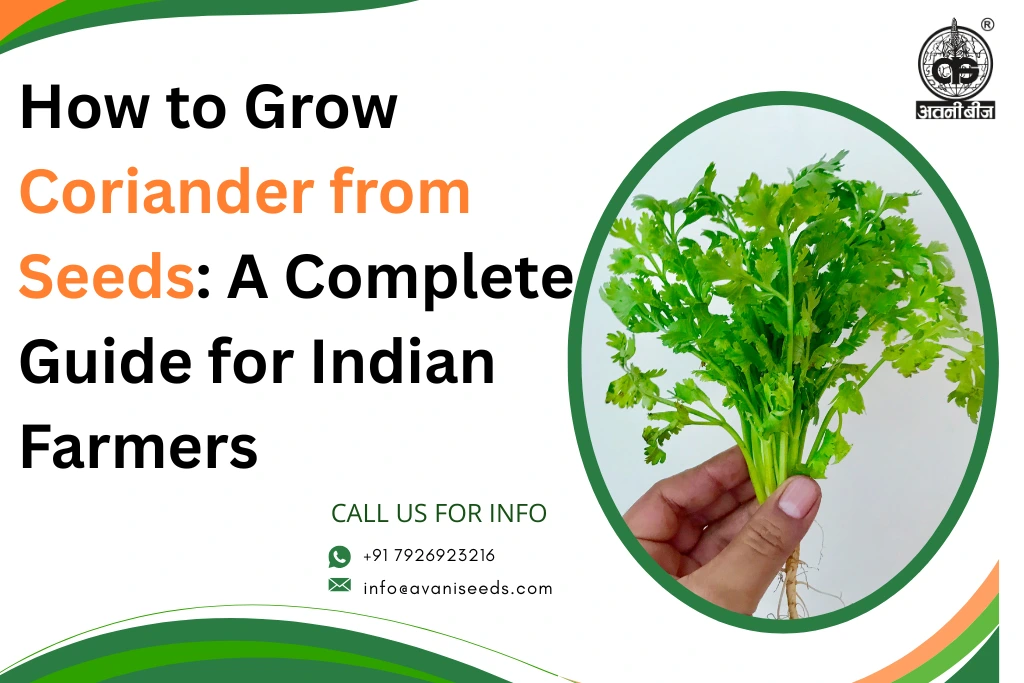Coriander, known as dhania in Hindi, is a staple herb in Indian kitchens and a valuable cash crop for farmers. From its fresh green leaves to its aromatic seeds, coriander is in high demand across local markets, food industries, and even international spice traders. If you’re a farmer looking to diversify or increase profits, growing coriander could be a smart choice.
In this blog, we offer a complete coriander cultivation guide for Indian farmers, including tips on soil preparation, seed selection, the best season to grow coriander in India, and how to achieve high yields.
Why Grow Coriander?
Coriander is a short-duration crop, maturing in 90–120 days. It thrives in a wide range of climatic conditions and requires minimal inputs compared to other cash crops. In addition to its market demand, coriander also improves soil fertility, making it an excellent option for crop rotation.
Best Season to Grow Coriander in India
One of the most important questions farmers ask is: what is the best season to grow coriander in India?
Coriander is a cool-season crop. The ideal time for sowing is from October to November in northern India and June to July in southern regions with mild monsoons.
Avoid sowing during peak summer or heavy rainfall periods, as extreme heat or excess moisture can damage germination and plant growth.
Step-by-Step: How to Grow Coriander Seeds in India
1. Soil Preparation
Coriander prefers well-drained loamy soil with a neutral pH (6.5 to 7.5). Avoid heavy clay or water-logged soils. Before sowing, plough the field thoroughly to remove weeds and prepare a fine seedbed.
Apply well-decomposed farmyard manure (FYM) or compost at the rate of 8–10 tons per acre during land preparation.
2. Seed Selection
Choosing the right seeds is crucial. Use high-quality, disease-resistant seeds from the best agriculture seeds suppliers in India. Farmers looking for bulk purchase should consider sourcing from a trusted Coriander (IMP) Seeds Producer in India to ensure purity and better yield potential.
3. Sowing Method
- Seed Rate: Use 8–10 kg of seeds per acre.
- Seed Treatment: Soak seeds overnight and split them slightly before sowing to improve germination.
- Spacing: Maintain row spacing of 30 cm and plant spacing of 10 cm.
- Depth: Sow seeds at a depth of 1.5–2 cm for proper root development.
Sowing can be done either manually or using a seed drill for better uniformity.
4. Irrigation
Coriander needs moderate watering. First irrigation should be given immediately after sowing. Subsequent irrigation should be scheduled every 10–15 days depending on soil moisture and climate. Avoid overwatering, especially during early stages.
5. Fertilizer Application
Apply 20 kg of nitrogen and 30 kg of phosphorus per acre. Divide nitrogen into two doses—apply half at the time of sowing and the rest after 30 days.
Organic farmers can use vermicompost and biofertilizers like Azospirillum for nutrient management.
6. Weed Control
Weeding is essential during the early growth stage. Manual weeding can be done 2–3 times during the crop cycle. Mulching with organic material helps retain moisture and suppress weed growth.
Pest and Disease Management
- Aphids and cutworms are common pests. Spray neem oil or recommended biological pesticides to control them naturally.
- Diseases like powdery mildew or damping-off can affect growth. Use disease-free seeds and avoid waterlogging to prevent fungal infections.
Regular monitoring and using organic pest management methods can keep the crop healthy without chemical residues.
Harvesting and Post-Harvest
- Leaves: If growing for leaves, harvest begins 30–40 days after sowing.
- Seeds: For seed production, harvest when the plants turn yellow-brown and the seeds are fully mature (about 90–110 days). Uproot plants and dry them in the shade before threshing.
Store seeds in a dry, cool place in airtight containers to maintain aroma and quality.
Tips to Maximize Yield and Profit
- Always source seeds from a certified Coriander (IMP) Seeds Producer in India to ensure better quality and uniform germination.
- Rotate coriander with other crops to improve soil health and reduce pest cycles.
- Consider selling in wholesale spice markets or forming farmer producer groups to negotiate better prices.
- Explore organic cultivation, which fetches premium rates in both domestic and export markets.
Conclusion
Understanding how to grow coriander seeds in India can open new income opportunities for farmers, especially when done with the right techniques and high-quality inputs. This coriander cultivation guide for Indian farmers is designed to help you get started with confidence—from seed to market.
Whether you’re a smallholder or a commercial grower, investing in quality seeds from the best agriculture seeds suppliers in India and staying updated with the latest farming practices will ensure a successful harvest.



